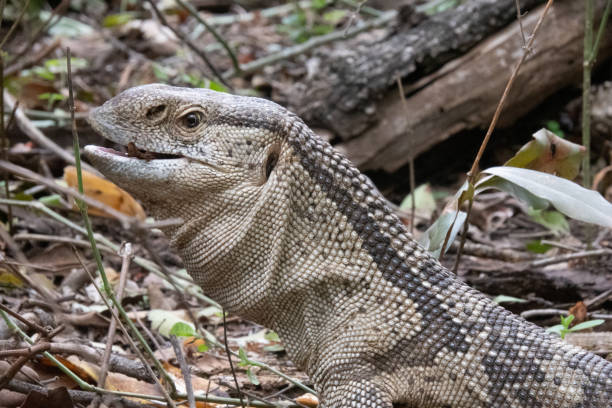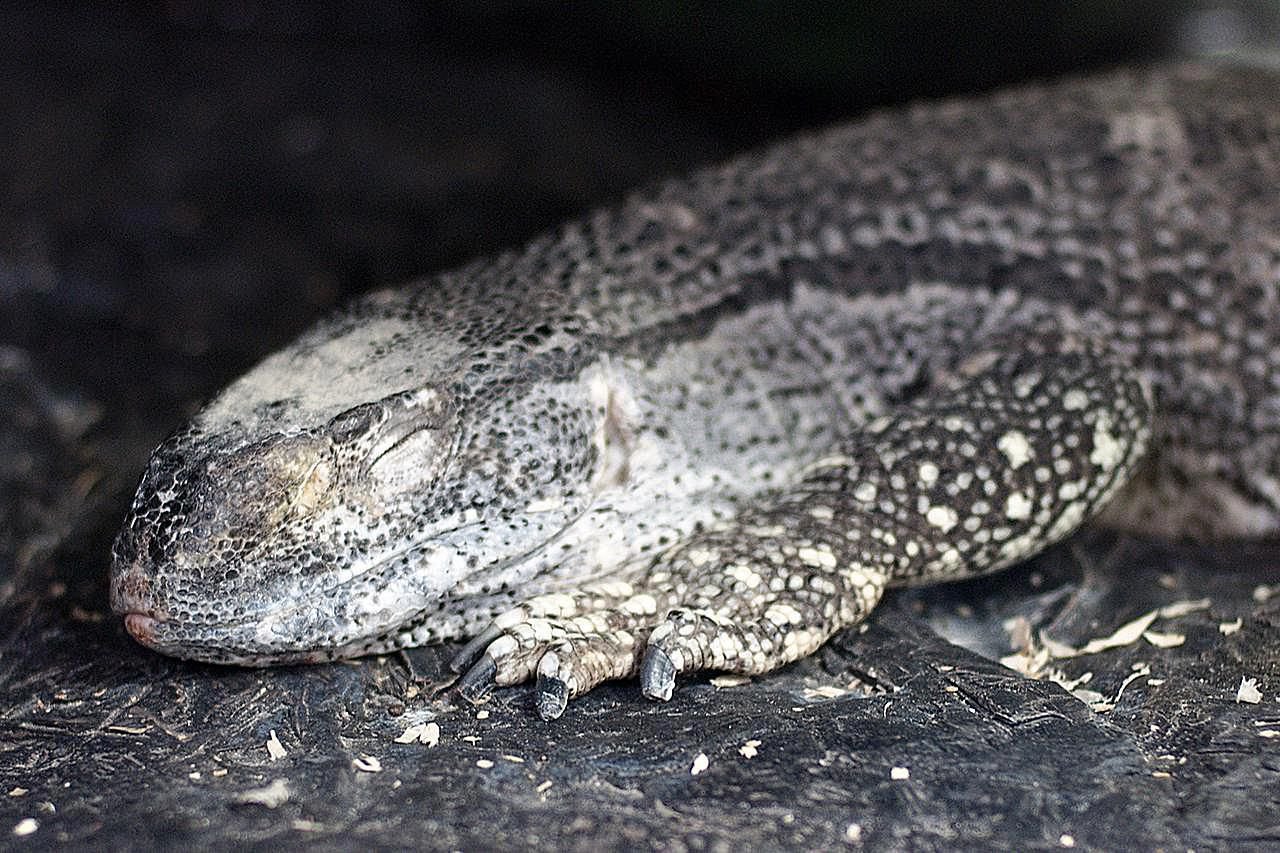The black-throated monitor is a large and playful lizard native to Tanzania, known for its bulbous snout, forked tongue, and mottled scales. If not handled regularly, these monitors may become aggressive and can cause serious damage with their bites.
Despite possessing venom, it is not fatal to humans. With short but strong legs, big claws, sharp teeth, and a long fat tail, black-throated monitors are considered gentle giants in nature. They are the second longest and largest monitor lizards in Africa and the largest of the four subspecies of rock monitors.
In this species profile, we will explore their housing, behavior, feeding, and health.
Overview Of Black-throated Monitor
The black-throated monitor, scientifically known as Varanus albigularis microstictus, is a subspecies of monitor lizard native to Tanzania. This large and playful lizard has a distinctive black throat and is often sought after by reptile enthusiasts for its unique characteristics. In this species profile, we will discuss the description, habitat and distribution, as well as the behavior and temperament of the black-throated monitor.
Description Of The Black-throated Monitor
The black-throated monitor is easily identified by its bulbous, convex snout, which gives it a distinct appearance. It has a tongue that is forked, pink or bluish in color, and often used for sensing its surroundings. The lizard’s body is covered in mottled gray-brown scales with yellowish or white markings, making it a visually striking species.
Habitat And Distribution
The black-throated monitor can be found in various regions of Tanzania, particularly in dry savannahs and woodlands. It prefers areas with moderate vegetation and access to water sources. This species is well adapted to its environment and can often be seen basking in the sun or hiding in rock crevices.
Behavior And Temperament
The black-throated monitor is known for its playful and curious nature. It exhibits both diurnal and nocturnal behavior, allowing it to explore its surroundings in the day and hunt for food at night. This species is primarily carnivorous, feeding on a diet of small vertebrates, insects, and occasionally scavenging for carrion.
While black-throated monitors can be relatively docile when properly socialized, they may become aggressive if not handled regularly by humans. In captivity, it is essential to provide proper socialization and enrichment to prevent the development of aggressive behaviors. When feeling threatened or stressed, these lizards have the ability to puff up their bodies and hiss, and in some cases, bite if provoked. Caution should be exercised when interacting with these large animals due to their strength and potential for causing serious harm.

Credit: www.shutterstock.com
Caring For A Black-throated Monitor
The black-throated monitor (Varanus albigularis microstictus) is a large but playful lizard that requires proper care and attention to thrive in captivity. In this section, we will discuss the housing requirements, feeding, watering, as well as lighting and temperature needs for this unique reptile.
Housing Requirements
Creating a suitable habitat for your black-throated monitor is crucial for its overall well-being. Here are some key points to consider:
- Provide a spacious enclosure that mimics the natural environment of the lizard. The enclosure should be at least 6 feet by 4 feet in size.
- Use a terrarium or reptile-safe enclosure made of glass or wood to provide a safe and secure space for your monitor.
- Add branches, rocks, and other climbing structures to create an enriching and stimulating environment for your lizard.
- Use a substrate such as cypress mulch or coconut husk that retains moisture and allows for burrowing.
- Ensure proper ventilation and humidity levels within the enclosure, aiming for a humidity level of around 70%.
Feeding And Watering
A balanced diet is essential for the health of a black-throated monitor. Here’s what you need to know:
- Feed your monitor a varied diet consisting of insects, rodents, and small mammals. Offer a variety of prey items such as crickets, mealworms, mice, and small birds to meet its nutritional needs.
- Supplement the diet with calcium and vitamin D3 to prevent deficiencies and promote healthy bone growth. Dust the prey items with a reptile-specific calcium supplement before feeding.
- Provide a shallow water bowl or dish that is large enough for the monitor to soak in. Change the water daily to ensure cleanliness.
- Monitor your lizard’s feeding habits and adjust the portion sizes accordingly. Avoid overfeeding to prevent obesity and other related health issues.
Lighting And Temperature
Proper lighting and temperature are crucial for the overall health and well-being of a black-throated monitor. Here’s what you need to know:
- Provide a basking area in the enclosure with a temperature of around 100°F (37.8°C). This allows the lizard to regulate its body temperature.
- Use a combination of UVB and UVA lighting to mimic natural sunlight. UVB lighting is essential for the synthesis of vitamin D3, which aids in calcium absorption.
- Ensure a temperature gradient within the enclosure, with cooler areas ranging from 80-85°F (26.7-29.4°C) and warmer areas reaching up to 95°F (35°C).
- Monitor the temperature and humidity levels regularly using thermometers and hygrometers to maintain the appropriate conditions for your monitor.
By providing the right housing, diet, and environmental conditions, you can ensure the health and happiness of your black-throated monitor. Remember to consult with a reptile veterinarian for any specific concerns or questions regarding the care of your lizard.
Interesting Facts About Black-throated Monitors
Black-throated monitors, also known as black-throat monitors (Varanus albigularis microstictus), are fascinating creatures with unique characteristics. Let’s explore some interesting facts about these impressive lizards:
Venomous Or Not
Contrary to popular belief, black-throated monitors are not venomous to humans. While they do possess venom, it is only strong enough to immobilize small prey, making it non-lethal to humans. So, you can rest easy knowing that these monitors pose no immediate threat with their venom.
Size And Physical Traits
Black-throated monitors are known for their impressive size and physical attributes. These lizards can grow up to 6 feet in length, with males being slightly larger than females. They have bulbous, convex snouts, which give them a distinct appearance. Additionally, they have mottled gray-brown scales with yellowish or white markings, making them quite visually striking.
Predators And Threats
Despite their intimidating size, black-throated monitors still have predators and threats to contend with. Young monitors often fall victim to larger predators such as birds of prey, snakes, and other carnivores. As they grow older, their size and strength become a formidable defense against these natural enemies.
In their natural habitat, human activities such as habitat destruction and illegal poaching also pose significant threats to the survival of black-throated monitors. Conservation efforts are crucial in protecting their population and preserving their habitat.
In conclusion, black-throated monitors are truly captivating creatures. While they are not venomous to humans, their size and physical traits make them stand out amongst other lizard species. However, they still face threats from predators and human activities, making it important to raise awareness about their conservation needs.

Credit: www.istockphoto.com

Credit: pixels.com
Frequently Asked Questions For Black-throated Monitor Species Profile
Are Black Throat Monitors Aggressive?
Black-throat monitors can become aggressive if not handled regularly. When threatened, they puff up their bodies and hiss, and they are known to bite, which can cause serious harm due to their size.
What Substrate Is Best For Black Throat Monitors?
The best substrate for black throat monitors is a mixture of soil, sand, and sphagnum moss.
How Big Does A Black Throat Monitor Get?
A black throat monitor can grow quite large, with adults reaching lengths of around 4 to 6 feet.
Do Black Throat Monitors Have Venom?
Black-throat monitors do possess venom, but it is not fatal to humans. The venom is only strong enough to knock out small prey.
Conclusion
The black-throated monitor lizard, also known as the black-throat monitor, is a fascinating and unique species. With its bulbous snout, forked tongue, and mottled scales, it is a sight to behold. While they can become aggressive if not handled regularly, their venom is not fatal to humans.
As gentle giants, they make for captivating pets. Whether you’re considering housing one or simply want to learn more about these incredible creatures, the information in this species profile will provide you with valuable insights.


